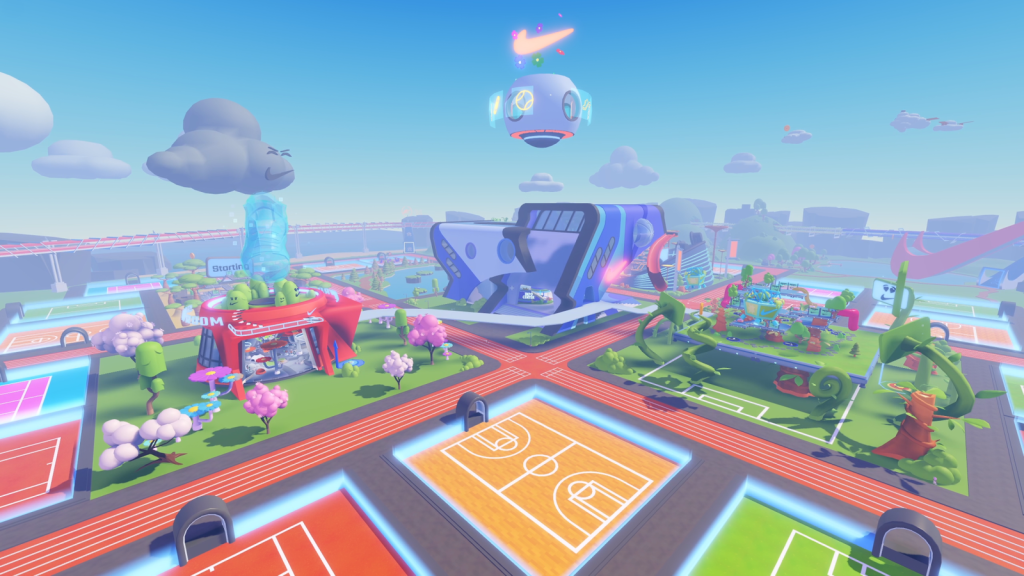“The Route Taken By Adidas With Sandbox And Nike With Roblox Signifies To Me A Stark Difference In Strategy.”
December 3, 2021
Back again. Talking about the metaverse. What’s new, huh?
Well, turns out, quite a lot!
The past few weeks have seen the two giants of the merchandising business, Nike and Adidas, who are always head to head IRL, reveal their hands for the next frontier – within the metaverse.
Nike made headlines by launching ‘Nikeland’ on Roblox, which has over 47 million active users; whilst also filing multiple patents for ‘virtual goods’.
Adidas this week launched the ‘Adiverse’ on Sandbox, a decentralised gaming platform that has a significantly lower active user base of over 200,000; whilst also launching with Coinbase, BAYC (Bored Ape Yacht Club) and other key projects and influencers in the space.
“The route taken by Adidas with Sandbox and Nike with Roblox signifies to me a stark difference in strategy. One long-term, one short-term.”
You might be thinking 47 million vs 200,000 active community users – what sense does that make? Nike is dwarfing Adidas in terms of reach. Why aren’t Adidas just launching into Roblox too?
Well, I’d argue it’s not as simple as that, and the route taken by Adidas with Sandbox and Nike with Roblox signifies to me a stark difference in strategy. One long-term, one short-term.
These differences boil down to 5 key areas (Platform, Technology, Community, Currency & Experiences), where they are at loggerheads:
| Nike | Adidas | |
| Platform | Roblox | Sandbox |
| Technology | Web 2.0 | Web 3.0 |
| Community | Mass Audience | Growing Audience |
| Currency | Fiat (Robux) | Cryptocurrency (SAND) |
| Experiences | Entertainment | NFTs |
Platform
Both Roblox and Sandbox are incredible innovators and fantastic platforms.
Their platforms offer users the opportunity to build, buy and sell a number of virtual assets like accessories (which is obviously great news for the likes of Adidas & Nike to help build brand awareness with the users of Sandbox & Roblox).
Both give power to their players to be the creators (which is a very important theme I’ll touch on later when we hit the community section), which in turn gives the users a sense of ownership (but of course ownership is a key differentiator between web 2.0 & web 3.0 that I’ll talk about within the currency section).

Both platforms have seen an incredible rise in brand partnerships with the likes of Adidas & Nike, with the theme of ‘metaverse activation’ becoming the norm (check out Balenciaga launching a metaverse business unit for confirmation). The experiences that these platforms like Roblox, Sandbox, Somnium space, Fortnite and the like can generate are incredible as you have no real life restrictions.
Technology
So the obvious differentiator here is that Adidas has opted to go down the route of a Web 3.0 blockchain powered game like Sandbox, whereas Nike has gone with a traditional Web 2.0 gaming platform.
Why is this important? Are they both not in the metaverse?
They are indeed, and although it’s refreshing to see brands diving into unknown territories, I do certainly feel that Adidas, with their partnership with Sandbox, are thinking much more strategically and long-term than Nike by embracing web 3.0 and the community that comes with it.
With the opportunities that blockchain based games bring by shifting the power to the users rather than the publishers through its play-to-earn model, it allows players and brands alike to become key stakeholders in growing the popularity of the platform and virtual world.
This is a win-win-win:
- Good for the platform like Sandbox as users keep playing as they can monetise their creations in the virtual world.
- Good for brands as they can activate and add value to the platform by bringing unique experiences.
- Good for the user as they have the power to build their own reality in a decentralised ecosystem that rewards them for engagement in the community.
Community
Community; a word we’ve all been talking about for years in sports, but has real meaning within the gaming and blockchain communities.
Authenticity and a sense of building for the good of the community is ever-present within these two communities. WAGMI, right?
Nike’s move into Roblox is smart in this sense as they tap into a huge audience and a demographic that they can now engage with in an authentic way with ‘Nikeland’.
However, Adidas’ launch into Sandbox, as well as with BAYC and Coinbase, to me, signifies that the digital team don’t just understand the space, but also understand how to connect with the communities that they are trying to target. It seems the beginning of a comprehensive metaverse strategy, and I’m excited to see where it goes next.
Overall, Adidas’ use of a web 3.0 platform makes more sense to me in the long-term, as I believe the power will soon move from the publishers / game developers over to the users, and blockchain technology will be the facilitator of this transition.
Currency
How many of your children have made you buy Robux for the latest ‘skin’ within the game? So maybe you’re up to date with the currency within the game already!
It’s relatively straightforward, and mimics the likes of EA Sports FIFA with FIFA points, where Fiat currency is used to buy in-game currency, which can allow a user to buy additional items within the game.
The likes of Sandbox and blockchain games differ in this sense.
“The caveat to this is that publishers / game developers will need to build open source so that it is possible. I’m hopeful this happens as it brings a whole new meaning to building digital personas.”
The user is of course still able to convert fiat currencies into SAND coin for example, which they can then use to buy LAND (virtual land). These virtual assets that are acquired can however rise or fall in value like any asset, but the key thing is of course because the assets have been purchased on a blockchain, the user will have true ownership of the asset, rather than it just being a virtual asset owned by potentially multiple people within a game like Roblox/FIFA etc.
The interesting part for me with this is in 5,10 or 15 years, when the metaverse is more developed, will be the interoperability of these metaverses, which will mean that any virtual asset owned by a user in any virtual world (whether that be Sandbox, Somnium Space or Roblox) can be used across any of them.
The caveat to this is that publishers / game developers will need to build open source so that it is possible. I’m hopeful this happens as it brings a whole new meaning to building digital personas.
More places for me to wear an Arsenal jersey, the pain…
Experiences
Lastly is the experience side.
‘Nikeland’ certainly brings a cool experience, and the likes of NASCAR & NFL have jumped on this too.
Being able to offer a digital experience via the likes of Roblox undoubtedly opens up huge opportunities to introduce the users to your sport, educate them on it and attract them to IRL events.

We’ll certainly see more and more sports orgs and brands engaging in this way in the coming months. On the flip side are the Web 3.0 platforms, and the way that experiences are generated on them.
And this brings us back to the Collins Dictionary word of the year – NFTs.
NFTs, being a vehicle of blockchain technology, integrate extremely well into blockchain powered games like Sandbox etc, and can bring some incredible experiences with them.
A good example of this is that NFTs can directly correlate to virtual assets. For example, a yacht NFT, that allows you to have the yacht within Sandbox sold for $650,000. An extreme example, but it showcases what is possible with NFTs. Keep an eye out on Adidas’ partnership with Coinbase – I imagine Adidas may be a launch partner of Coinbase’s NFT platform…
This opens up a huge opportunity for sports orgs to develop NFTs that grant access to exclusive experiences within blockchain games, and the possibilities could be endless (viewing parties of matches, exclusive content, exclusive merchandise etc).
NFTs offer the benefit of true digital ownership, trading, security, immutability and cross-platform interoperability for users, which clearly adds value to any experience on a Web 3.0 platform in comparison to a Web 2.0 platform.
To conclude, I think one of the best things I have heard to describe this shift in mindset is to discuss how generations perceive value.
Boomers/Gen X saw value in physical collectibles and experiences.
“Gen Z/Gen A think we’re all stupid for ever having physical assets, but also having digital assets that we can’t trade/use between different virtual worlds.”
Millennials began to place the same value on digital assets, and began spending money on digital collectibles and experiences.
Gen Z/Gen A think we’re all stupid for ever having physical assets, but also having digital assets that we can’t trade/use between different virtual worlds. This is where interoperability becomes so pivotal.
This is the next step, and one that sports organisations and brands need to be able to follow, because it will all move at a frightening pace over the next couple of years.
(On a side note: Congrats to both Nike, Adidas, NFL, NASCAR and anyone that has made the leap into the metaverse – innovators will be winners).


